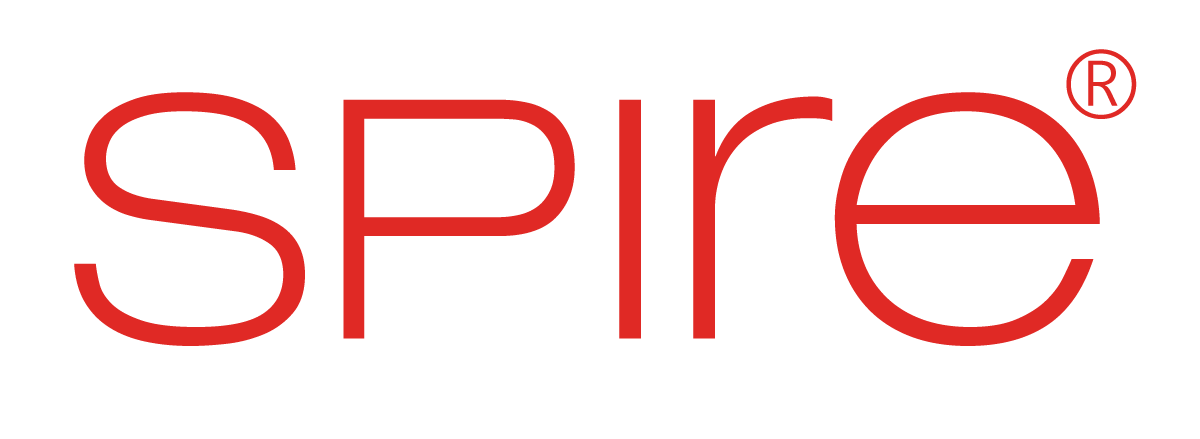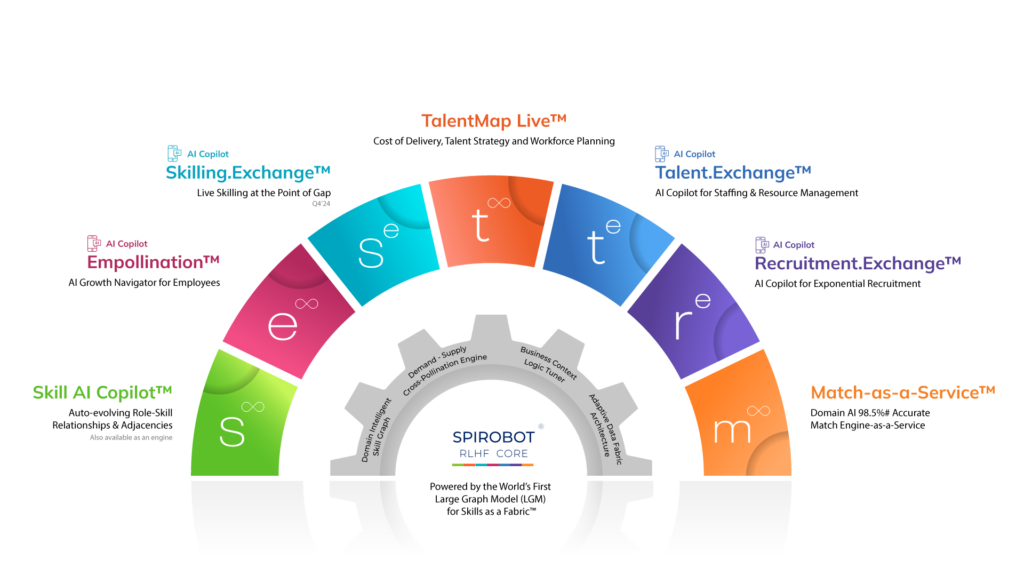This article will help you navigate the business growth path with a consistent future-ready workforce approach by providing a step-by-step guide on how to transform your organization into a skill-based organization.
Spire.AI’s cutting-edge domain-intelligent AI, powered by a Large Graph Model (LGM) for Skills, and revolutionary talent development approach leads to a demonstrably enhanced employee experience. It provides a ready-to-adapt platform and workflow to initiate your transformation journey today.
Current Organization Structures and Limitations
Broken Talent Management: How Traditional Systems Hinder Employee Growth and Innovation
In most organizations today, employee experience journeys are often supported by manual, time-consuming, and reactive workflow talent systems. Even after implementing these talent systems, tangible outcomes are still missing for employees due to form-based data collection. This process is tedious and easily ignored by employees who are already occupied with increasing work demands and ongoing projects.
Current career development practices rely on a promotion system based on seniority rather than focusing on skills. This approach misses high performers who take the initiative to develop new skills independently. These self-motivated individuals often become frustrated by a lack of recognition and growth opportunities, leading them to seek employers who value their true potential.
Furthermore, the absence of structured training programs aligned with the organization’s evolving skill requirements creates a reactive approach to talent acquisition. Companies struggle to cultivate internal talent for new projects without clear learning paths. This reactive hiring strategy is time-consuming and significantly more expensive than nurturing existing talent.
A few of the challenges faced by role-based organizations:
- Incomplete and out-of-date employee skill profiles – The skills and expertise available for employees within the company are often inaccurate, insufficient, and not updated regularly. The limited available data is scattered across various systems and cannot be leveraged well.
- Reactive Talent Development – Traditional training programs and generic online learning resources often fail to address individual needs and emerging skill gaps, limiting employee growth and organizational agility.
- Limited Career Visibility – Employees do not have a clear visibility of career paths or an understanding of how to navigate career development, leading to disengagement and frustration.
- Ineffective Internal Talent Marketplace – Employees cannot find new opportunities through the existing platform as it is discovery-driven for employees, and there are no proactive alerts for employees for internal growth opportunities. Furthermore, the employee-to-job match mechanisms are ineffective and restrictive for talent to flow within with mobility opportunities.
Solutions for Overcoming the Limitations of Traditional Talent Management Systems
Building a Future-Proof Talent Strategy: The Power of the Skills-Based Organization Framework
To transform into a Skills-Based Organization (SBO), enterprises need an auto-evolving role-skill framework that generates, evolves, and adapts to the continuously changing roles and skills context of their industry and powers one integrated, adaptive platform to simplify and future-proof the way talent is acquired, deployed, managed, reskilled, grown, and retained. Transparently.
It allows for a single role and skills backbone to be used across the talent processes by creating a common language for all talent stakeholders to collaborate.
| Challenge | Solution |
| Overcoming the lack of sufficient data and the administrative burden of data collection | Automated Skill Profile Generation |
| Reducing subjectivity in employees’ current roles and skill requirements | Automated Employee Current Role Identification and Mapping |
| Lack of guidance for employees about what to learn to be current role proficient and future-ready | Skill-Gap Identification and Reskilling Recommendations |
| Lack of visibility of current open opportunities within the organization to convert learning into experience-building | Internal Growth Talent Marketplace |
- Overcoming lack of sufficient data and administrative burden of data collection – Automated Skill Profile Generation
The SBO framework enables the creation of a single source of truth and a robust employee data ecosystem by aggregating and analyzing employee data from various sources using built-in skill intelligence. It will provide data enrichment options by correlating data between different talent functions to maximize the limited data available.
Furthermore, it will boost employee self-awareness by empowering individuals to understand their skills, expertise, and areas for development through an all-round skill profile view.
- Reducing subjectivity in employee’s current roles and skill requirements – Automated Employee Current Role Identification and Mapping
SBO leverages skill and role intelligence to identify employees’ current roles through a data-driven comparison of their aggregated skill sets extracted from various sources with the pre-defined skill sets within the Auto-Evolving Role-Skill Framework
An automated process of role mapping to the employees using an intelligent matching engine eliminates the subjectivity that the manager / HR team’s understanding-based manual role mapping brings.
- Lack of guidance for employees about what to learn to be current role proficient and future-ready – Skill-Gap Identification and Reskilling Recommendations
The SBO framework brings a tight correlation between the skills gaps and the learning paths.
Proactively identifying critical skill gaps before they impact performance and personalized learning recommendations are made available based on the individual context and needs.
- Lack of visibility for employees on the organization’s growth paths – Role-Skill Framework-based Career Development Path Simulator
SBO provides clear career pathways to equip employees with roadmaps to achieve their career aspirations. It facilitates smooth transitions between roles within the organization and enables organic succession planning by identifying and nurturing future leaders for key positions.
- Lack of visibility of current open opportunities within the organization to convert learning into experience building – Internal Growth Talent Marketplace
SBO framework helps compare the employee’s skill context with learning options included with the demand requirement context in its entirety and maximizes the visibility of relevant jobs for employees to explore and apply for internal opportunities. This promotes transparency and fairness and ensures everyone has equal access to career advancement opportunities, thus boosting employee morale and engagement and improving retention. It encourages a culture of growth and development.
With intelligently aggregated skill profile data, SBO enables the identification of hidden talent and matching employees to suitable roles, maximizing internal talent utilization.
How Spire.AI – A Skills-Based Talent Platform Powered by Domain-Intelligent AI – Helps Organizations Embrace the New Age Talent Management Solutions
Introducing Spire.AI Copilot for Talent, a full stack Talent platform powered by Domain-Intelligent AI and the World’s First Domain Intelligent Large Graph Model (LGM) for Skills
Spire.AI provides a demonstrably enhanced employee experience with automated generation of employee skill profiles, real-time career development path simulations and reskilling recommendations, and an internal talent marketplace.
Spire.AI allows organizations to be nimble and scalable by enabling hiring managers, HR business partners, workforce managers, recruitment teams, and learning managers with seamless end-to-end talent supply chain operations using a skills-first approach.
It is the world’s most sophisticated platform that helps organizations in their journey toward transformation into a skill-based organization. The major functional workflows that Spire.AI delivers to the SBOs are outlined below
- Role-Skill Framework: This Auto-Evolving Role-Skills framework, fuelled by the world’s largest LGM for skills, is tailored to every industry & adaptable to changing business contexts. It serves as the single source of truth for role and skills data across the organization.
- Automated Skill Inventory & Profiling: An automatic all-round skill profile view for every employee in the organization built by aggregating and analyzing employee data scattered across the enterprise systems, reducing manual effort by employees and HR teams.
- Employee Career Paths and Reskilling: Unlocking employee potential with career path simulations aligned with aspirations, mobility opportunities, and future talent vision. Personalized reskilling plans for employees to navigate their chosen career path.
- Talent Marketplace & Internal Talent Management: A dynamic platform that continuously matches every employee to all open roles and recommends the right-fit jobs with proactive opportunity alerts, fostering internal mobility and enhancing talent utilization and retention.It also acts as an AI Copilot for internal talent management teams to maximize internal fulfillment through proactive planning of upskilling and effective succession planning to maintain a healthy pyramid and talent utilization.
- Talent Acquisition: This AI Copilot for talent acquisition is designed to optimize TA operating models, speed up sourcing, screening, and recruiting operations, and deliver exponential performance to recruiters and stakeholders.
Transformation to an SBO : Your Step-By-Step Guide Using Spire.AI Talent Solutions
Spire.AI is a full-stack talent platform that unlocks significant benefits for organizations and employees through a skills-first approach. Organizations gain a data-driven approach to talent management, optimizing internal talent availability, upskilling /reskilling efforts, boosting internal mobility, and reducing recruitment costs.
Employees experience empowered career development, personalized learning opportunities, and increased access to internal growth opportunities, leading to higher engagement and improved performance
This section delves deeper into how Spire.AI consistently facilitates each step toward transforming organizations into Skill-Based Organizations with a future-ready workforce.
Step 1 – Effective Role-Skill Mapping With Spire.AI Auto-Evolving Role & Skill Framework
Spire.AI’s innovative Generative Role-Skill Framework revolutionizes and standardizes how organizations manage roles and skills. The auto-evolving framework provides a unique and ready-to-use FCPR construct in which the roles and skills of each industry are compiled.
Any organization can subscribe to the Spire.AI Role skill library, add its own organizational context, and start using the framework as is from day 1.
This Generative Role-Skill Framework enables a skills-first approach that acts as the underlying layer for all talent systems. Thus creating a uniform language for all the talent functions, businesses, and employees to collaborate smoothly. This framework seamlessly feeds the talent processes with the necessary data to optimize performance and decision-making.
It helps define the current and future roles of any organization in any industry and the skills needed to be proficient in those roles with a standard and structured construct, enabling organizations to become genuinely skill-based organizations.
Advantages of Spire.AI’s Role-Skill Framework
- Auto-evolving and avoids manual maintenance
- Complete with all the unique roles of the industry
- Ready to use and easy to adapt
- Customizable as per the context of the organization
- Agile catering to industries seeing rapid technology and business shifts
How Does Spire.AI Evolve its Role-Skill Framework:
Leveraging a domain-intelligent Large graph model skill cloud, Spire.AI generates and analyses the complex relationships between individual skills, roles, broader skills, industry trends, and required levels of expertise within a specific domain to evolve its Generative Role-Skill Framework.
Spire.AI’s role skill framework combines the Job Family-Skill cluster, Primary skill, and Role elements in an FCPR construct to define possible job variations.
Each FCPR provides granular and precise skill data for roles and their incumbent employees by outlining the specific skill sets required and calibrating them to the expected proficiency levels needed for the role and the employees.
Leveraging cutting-edge Domain-Intelligent AI-based algorithms, each FCPR skill is automatically calibrated for base, advanced, and expert proficiency levels.
Step 2 – All-Round Employee Skill Profile Generation
Spire.AI aggregates employee data from multiple HR systems and shows all employee skill context-related information in one place. It also allows employees to upload their resume, extracts all the skill information from the resume, and allows employees to self-verify the skill information. The skills, education, certification, and project experience information are extracted and loaded on the employee profile. In addition, the training and certification information from the organization’s LMS systems and project experience information from project management systems are aggregated and shown in one place. The employees can verify these extracted and assigned skills by updating their proficiency levels.
Managers will have a view of the complete profile of employees reporting to them. This includes employee skills, projects, roles, certifications, and learning data. Managers can validate the employee’s skill and proficiency by adding the manager-evaluated proficiency.
Employee skill profiles in Spire.AI act as a single source of truth to view the skill context of the employee with the validation status. Spire.AI reduces effort for employees, managers, and HR teams by aggregating employee skill context from various sources that are already existing and underutilized otherwise.
Through the automated generation of skill profiles, over 90% of employee profiles feature up-to-date skill information for multiple organizations that have implemented Spire.AI. This enables organizations to unlock the full potential of their internal talent pools with increased visibility of employee skills for efficient talent mobility and resource allocation, improved employee engagement, and building a continuous learning culture.
Step 3 – Employee Role Mapping & Validation
Now that the Role-Skill blueprint for the organization and the employee’s complete skill context are available, the next step is to map the current role for every employee in the organization and define all open and future demands in terms of the roles and skills as per the framework.
Spire.AI’s matching engine leverages its domain intelligence to identify employees’ current roles through a data-driven comparison of their aggregated skill sets from employee profiles against the pre-defined skill set requirement for roles as per the Generative Role-Skill Framework.
Spire.AI’s Skill Expertise Analyzer (SEA) further computes individual skill and role proficiency levels by identifying skill matches and gaps.
Employees can review the current role assigned to them and accept it or request a change if they feel the assigned role does not represent the job they are currently performing.
The automated mapping process, facilitated by the Spire.AI engine, has yielded 90%+ mapping of current roles for employees in one of our customers with 85% accuracy.
Step 4 – Demand Skill Selection Using Role-Skill Framework
One of the main issues that the talent supply teams face, be it internal workforce managers or recruiters, is that the demand created by the hiring managers does not give clear information about the required or good-to-have skill set for the job and the required proficiency levels.
Spire.AI facilitates demand creation with a simplified way of articulating the skill set needed for the job. Using the role skill framework, Spire.AI allows managers to choose the primary skill needed for the demand, and from there, it gives all the related skill sets to pick the required and good-to-have skills for the role. This way, there is consistency in the way demand is raised, and hence, the workforce managers can work on effective upskilling-based fulfillment from internal talent supply and avoid unnecessary hiring. Also, recruiters can attract the right candidates more efficiently through the relevant channels.
Step 5 – Skill Gap Identification and Reskilling Recommendations with Empollination
One of the main issues that the talent supply teams face, be it internal workforce managers or recruiters, is that the demand created by the hiring managers does not give clear information about the required or good-to-have skill set for the job and the required proficiency levels.
- Personalized Skill Gap Analysis – Spire.AI takes the guesswork out of reskilling by providing employees with a clear picture of their current skill set and how it aligns with their assigned role’s requirements. The system automatically analyses each employee’s skills, pinpointing areas where their proficiency falls short of expected.
- Skill Matching for Targeted Learning – Spire.AI goes beyond simply identifying gaps. It provides valuable skill mapping, highlighting:
- Exact matches: Skills that perfectly align with the role’s needs.
- Adjacent matches: Skills closely related to the role and potentially transferable.
- Gap skills: Skills that do not match the role’s requirements.
- Proficiency-Level Recommendations – The platform doesn’t stop at identifying skill gaps. It delves deeper, recommending specific reskilling pathways based on the required proficiency levels for each identified gap. This ensures employees focus on the most impactful areas for improvement.
- Data-Driven Insights with the Learning Matrix – Spire.AI “Learning Matrix” simulator empowers employees to make informed decisions about their learning journey. By simulating different skill combinations, employees gain valuable insights into the supply-demand ratio within the organization. This allows them to choose highly sought-after skills, enhancing their career prospects while aligning with the organization’s needs.
- Streamlined Learning Journey – Employees can easily “tag” skill gaps for learning, marking skills they wish to acquire for specific roles. Tagged skills go through a manager approval workflow, ensuring alignment of individual goals with the organizational goals.
- Seamless Integration with Learning Systems – Spire.AI seamlessly integrates with the existing learning management systems (LMS). When employees “Tag to Learn” a recommended skill, it automatically sends the information to LMS with their learning preferences, streamlining the personalized upskilling process.
Step 6 – Career Path Simulations and Reskilling Recommendations
One of the main issues that the talent supply teams face, be it internal workforce managers or recruiters, is that the demand created by the hiring managers does not give clear information about the required or good-to-have skill set for the job and the required proficiency levels.
Traditional career development frameworks are often static and lack structure and personalized guidance for employees. Employees struggle to identify suitable growth paths and the right skills to learn and navigate complex learning options. This disconnect can lead to disengagement, skill gaps, and missed opportunities for both the employees as well as organization.
Spire.AI Role-Skill Framework-based Career Path Simulator overcomes these challenges by providing a comprehensive career path simulator and development platform.
- AI-powered Career Path Recommendation: Based on the employee’s current role and skills, the Domain AI engine recommends a curated list of Future Career Roles based on the role-skill framework adopted by the organization.
Employees can explore both lateral and vertical growth paths, enabling them to visualize their long-term career progression within the company - Multi-faceted Learning Path Options: Spire.AI empowers employees to achieve their self-development goals through a wide range of simulation experiences while simultaneously building the skills and capacities crucial for the organization’s future.
- Self-Development/Aspiration-based path: Shows all the potential career growth path options based on the employee’s role, primary skill, and adjacent skills, reaching up to 4 levels above their current role
- Mobility-based Path: Shows growth paths where there are current open demand offering exciting career mobility opportunities within the company
- Future Capacity-based: Shows growth path in areas where the organization is building future talent pipeline, thereby aligning personal aspirations with organizational needs
- In-depth Role Fit Gap View and Learning Journey: Employees gain detailed insights into the skill requirements for each role within their chosen career path. Employees can instantly see their skill matches, adjacency matches, skill gaps, and the number of demands open for each role, enabling informed decision-making for upskilling. Employees can choose the relevant skills and mark them as ‘Tag to learn’, and the learning journey for the current, lateral, or vertical role journey seamlessly follows.
- Aspirational path: Employees can choose the roles in lateral or vertical progression and save their aspirational career paths. This will be visible to Managers, HR teams, and L&D teams for training design and planning.
Learning content discovery tightly coupled with the aspirations
The skills tagged by the employees for learning are visible in the learning systems, where they can start their learning journey, HR teams can plan relevant interventions, and L&D teams can design, curate, and deliver learning. relevant interventions can be prioritized and executed based on the number of employees subscribing to specific courses.
Spire.AI provides a consolidated view of the skills tagged to be learned by the employees so that L&D teams can decide on the learning design and training delivery. Since the learning is tagged against aspired roles, the HR teams have a view of the employees’ interest in learning and create organization-level interventions to keep the learning culture alive.
Step 7 – Creating a Vibrant Internal Talent Marketplace
Spire.AI internal talent marketplace promotes an internal-first hiring strategy and fosters internal mobility by providing opportunities to available employees before opening jobs to external candidates.
Matching Job Recommendations for Employees: Domain AI-powered talent marketplace matches employees with current jobs or future pipeline-building jobs based on skills and experience without bias.
Employees are alerted about matching jobs and can search and apply for jobs through the live internal talent marketplace. They can also see their rank, probability of selection, and any skill gaps for the job. The configurable platform allows businesses to personalize the Talent Marketplace to meet organizational goals.
Employees can track their applications and status changes for the job they applied for. In addition, employees will also be able to see where all their profiles are recommended by HR and hiring managers.
Highlights of Spire.AI’s Internal Talent Marketplace
- Intelligent matching of every employee to open jobs
- Instant alerts to fit-gap for all internal opportunities
- Visibility to the probability of selection for the job
- Configurable for Business rules as per organizational need
E.g.: Allow employees to apply for jobs of the same level or 1 level higher. - Allow Employees to apply for other Business unit jobs if aging in the current Business unit beyond a certain timeline etc
- Increased Mobility for Organization: The internal talent marketplace caters to fulfill open jobs, projects, group assignments, and any gig opportunities with talent from within the enterprise. It helps employee growth and retention.
Benefits of Shifting to an SBO: How an SBO Model Will Help Organizations Sustain the
Evolving Rapid Business and Technology Shifts
- Employee alignments to roles: Spire.AI provides transparent visibility of role skill requirements and hence enables employees to calibrate their knowledge and prepare for further learning
- Self-initiated learning: Spire.AI provides a platform for employees to learn their preferred skills at their own pace, according to their aspirational career path, and be prepared for growth opportunities.
- Learning-based growth culture: By providing managers, employees, and talent function teams with the relevant talent metrics and skill requirements, Spire.AI consistently allows for building an agile, future-ready workforce.
- Learning ROI: By aligning employee learning in the areas of demand for the organization, the investments are well directed towards growth, and employees feel engaged in contributing to the organization.
- Improved Performance & Innovation: A skilled and engaged workforce leads to better performance and increased innovation.
- Reduced Costs: Spire.AI can help reduce recruiting, training, and talent turnover costs substantially.
- Enhanced Employee Engagement: Spire.AI fosters a more engaged workforce by empowering employees to develop their skills and build careers.
- Marketplace & Talent Cross-pollination: Spire.AI helps unearthing hidden talent within your organization by matching employee skills to project needs. This fosters internal mobility and optimizes resource allocation.
- Skill Supply-Demand Ratio Insights: Get real-time data on your organization’s skill supply and demand. This allows for proactive talent management strategies to address future needs.
- Future-Proof Talent Strategy: Spire.AI helps your organization adapt to changing industry demands and technological advancements by focusing on skills.
Real Impact from a Recent Implementation
One of the leading Fortune 200 Communications companies has implemented Spire.AI, gone through the defined steps above, and successfully transformed itself into a skill-based organization.
- Spire.AI replaced multiple disparate talent systems and has provided a single full-stack talent platform.
- The client uses all the Spire.AI modules.
- Employee profile builder where 100% of the employee’s all-round skill profile is visible to the relevant HR teams and managers
- Employee career development page where they can view the lateral and vertical career/learning paths, build their aspirational path, and tag skills to learn to realize their aspirations.
- Internal career marketplace, which has enabled employee mobility to growth opportunities
- Create demand calibrated for clarity in skills and job descriptions
- Talent Management page, which allows HR teams to view the best matching supply for all demand to maximize internal fulfillment
- Employee selection as per the desired operating model of hiring from within as first priority, diversity hiring priority, and deprioritizing expensive agency channel hiring
- A complete Applicant Tracking System that reduces recruiters’ effort by bringing the job posting through multiple channels, best candidate matches, end-to-end interviews, and feedback management
Success metrics for the implementation
- 99% of their demand is calibrated for skill clarity
- 90%+ of the employees are mapped for the current role
- Agency hiring reduced to 1% from 30%+
- 3X increase in internal job application processing
- 5X increase in applicants matching demand
FAQs
What is a skill-based organization?
A skills-based organization is a modern organization operating model defining work through specific tasks and activities to achieve set goals. This flexible and agile business model prioritizes the development and utilization of skills and human capabilities.
What are skills?
Skills encompass essential knowledge, competencies, and abilities for operational tasks. They are learned abilities to execute tasks effectively and produce determined results.
How does a skill-based organization work?
A skill-based organization works by outlining tasks and activities needed to achieve specific outcomes. This involves deconstructing traditional roles and breaking them into more defined components that articulate the ‘work to be done.’ Skills-based organizations redefine talent management practices, emphasizing the development and utilization of employee skills.
What are the challenges faced by companies transitioning to SBOs?
The challenges faced by companies transitioning to SBOs are listed below.
- Senior resistance, unclear skill needs, outdated tools, resistance to change.
- Skill visibility, data collection complexity, managing skill gaps & pay equity.
- Over-focus on skills, responsible use of AI & workforce data, and accuracy of predicting future skills.
What is the skills-based organization model?
A skills-based organization model prioritizes employees’ skills and abilities over their job titles. It fosters flexibility, agility, and innovation by matching people to projects based on their competencies.
What is a skill-based structure?
A skill-based structure is an organizational framework where roles and teams are formed around specific skills rather than traditional departments or hierarchies.
What is a skills-based approach?
A skills-based approach focuses on developing and utilizing employees’ skills to drive business outcomes. It emphasizes continuous learning, skill development, and talent optimization.






